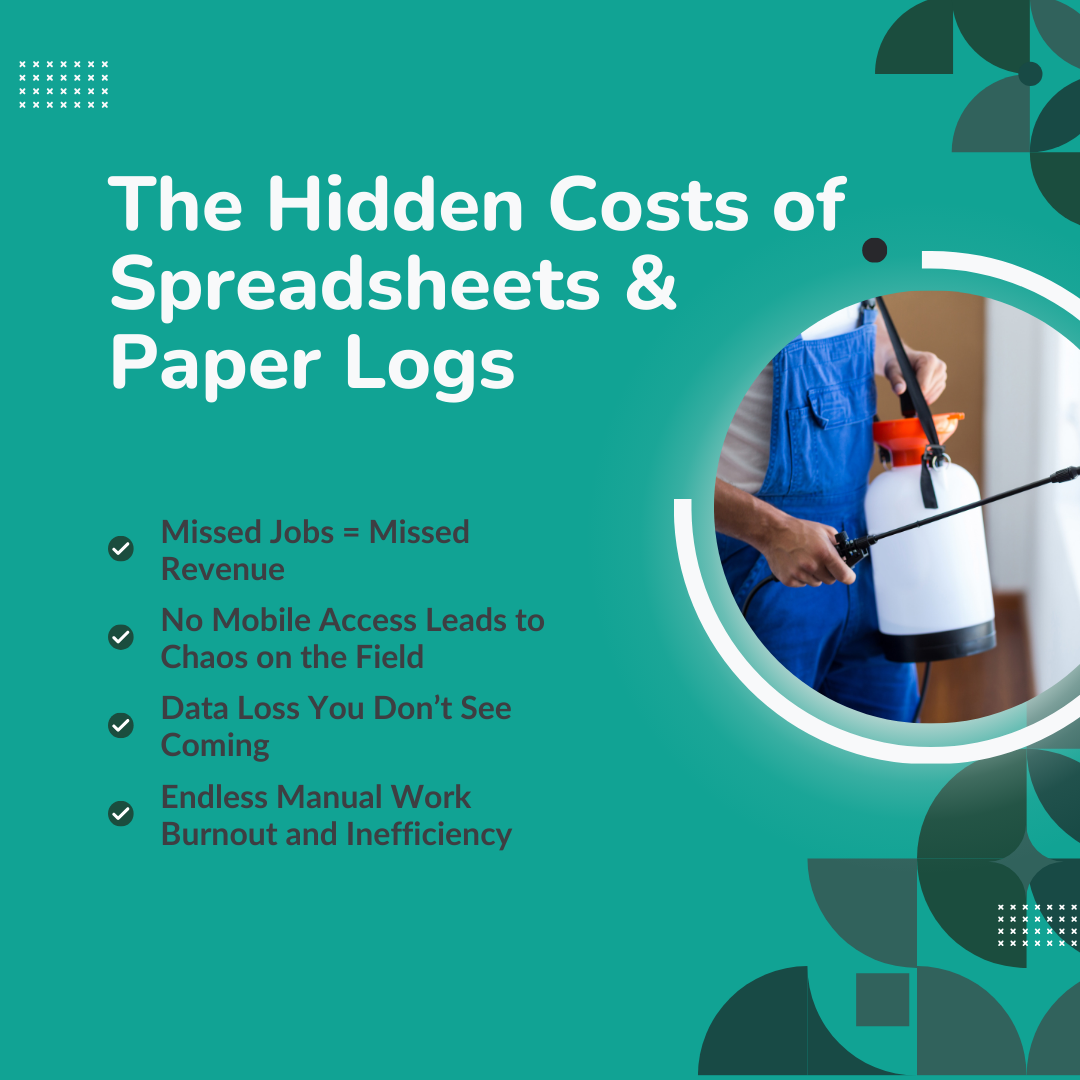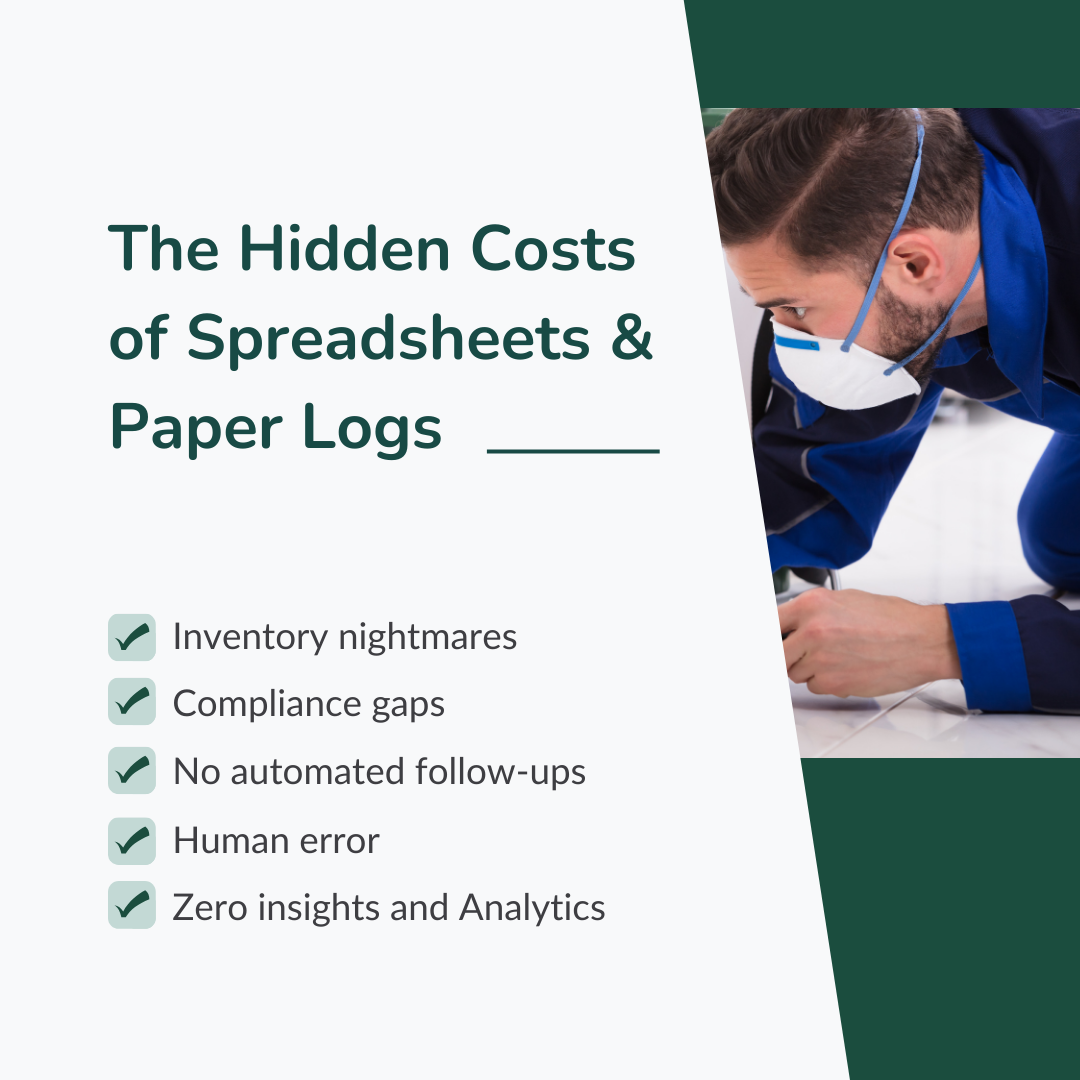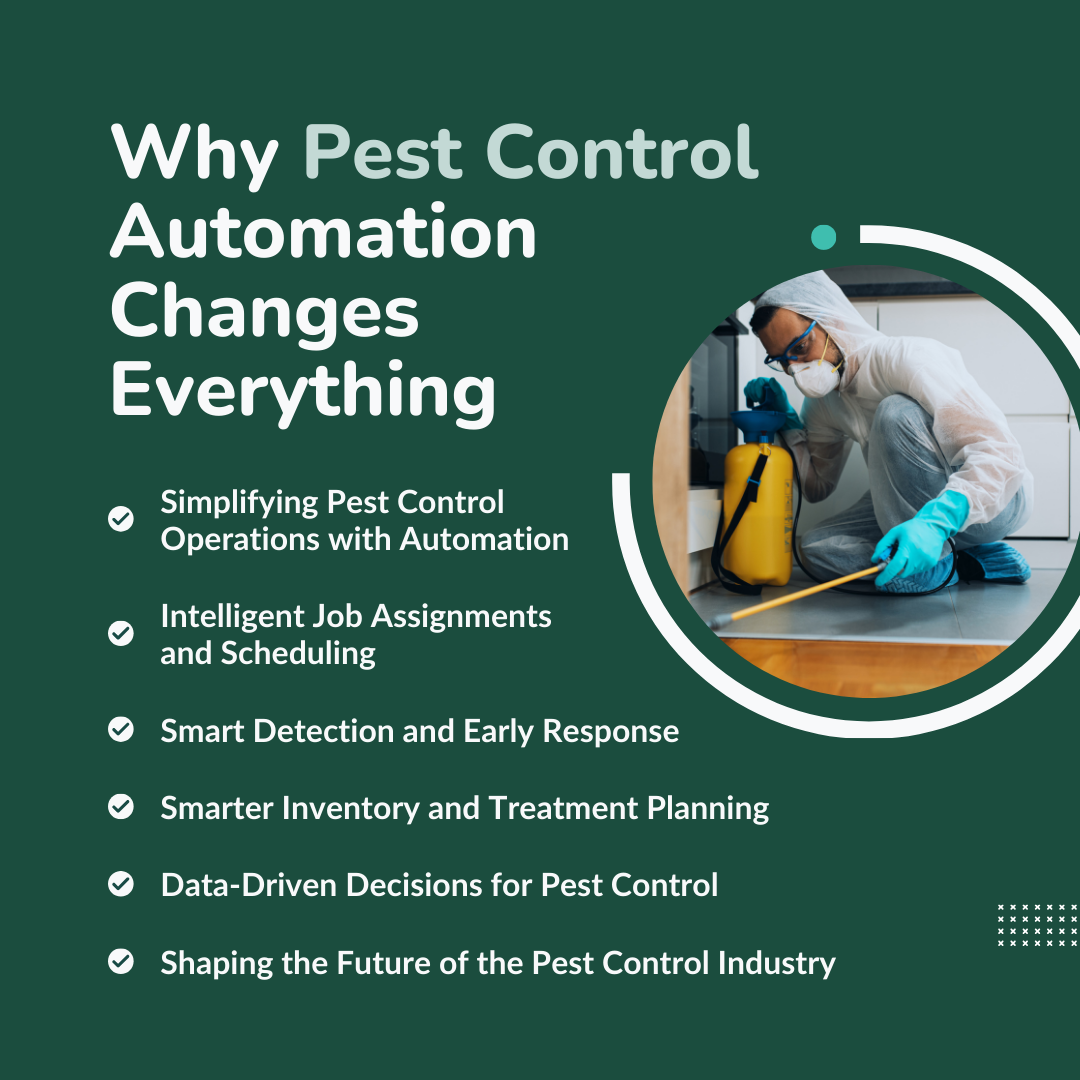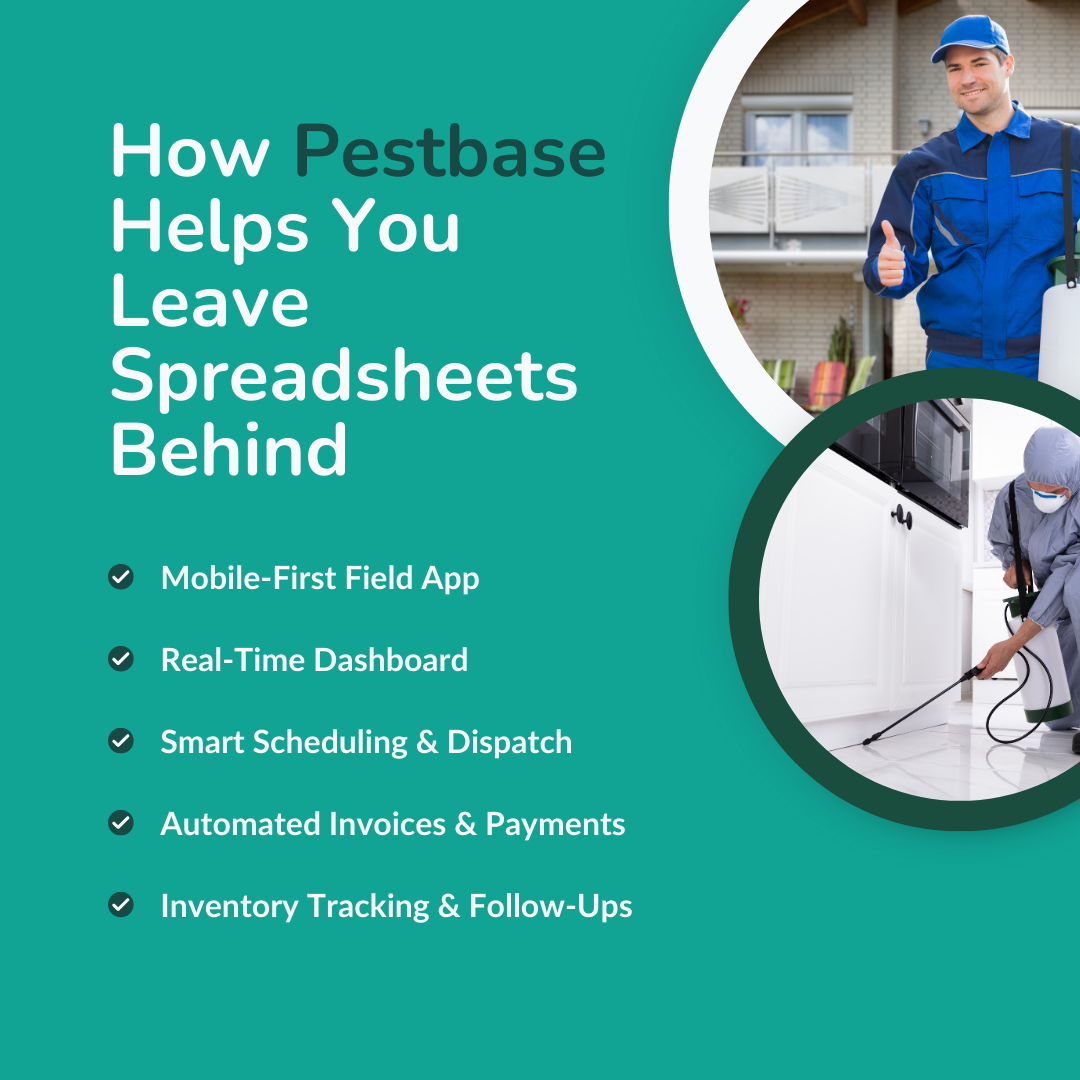August 27, 2025
Still using Excel to manage your pest control business? You might be doing more harm than good.
In 2025, pest control isn’t just about spraying pesticides. It’s about smart decisions, fast service, and seamless automation.
The industry is exploding, with the global market size projected to reach $34.3 billion by 2030. But as demand grows, so do client expectations, compliance pressures, and operational complexity.
That’s where pest control automation helps keep up with the growing industry. Manual methods like spreadsheets and paper logs can’t match the efficiency of automated pest control systems, which identify pests, monitor infestations, and improve every part of your workflow.
Why Spreadsheets Are Hurting Your Pest Control Business
Let’s be honest, spreadsheets were never built for pest control. They weren’t made to track technician routes, send follow-up reminders, or manage inventory in real-time.
Yet many pest control companies still rely on them, thinking they’re “simple” or “cheap.”
In an industry where speed, accuracy, and compliance matter more than ever, automation gives you a competitive edge. It’s not about replacing your team. It’s about empowering them with tools that work as hard as they do.
This blog explores the hidden costs of outdated systems and how modern tools, such as PestBase, enable pest control businesses to save time, minimize errors, and deliver world-class service, all while effectively eliminating pests and inefficiencies.
Key Takeaways
- Spreadsheets can’t handle real-time pest control needs, and automation gives you visibility, speed, and accuracy.
- Manual systems waste time, increase risk, and limit your ability to scale in a rapidly growing industry.
- Modern pest control automation tools help track pests, reduce chemical use, and boost customer satisfaction.
- Leaving spreadsheets behind means making smarter, faster, and more informed decisions for your business.
The Pest Control Industry in 2025: Faster and Smarter Pest Management
Did you know? According to Future Market Insights, the pest control industry is expected to grow at a CAGR of 7.4%, reaching over $53.1 billion by 2035.
This rapid expansion is driven by stricter health regulations, increased commercial demand, and rising concerns about hygiene and safety. But with growth comes complexity.
1. Faster response times:
Clients now expect faster response times, digital service records, and zero room for error. And here's the truth: Manual systems like spreadsheets are slowing you down.
Missed jobs, double bookings, lost data, and hours of manual updates aren’t just frustrating; they’re costing you money and customer trust.
2. Automated pest control systems are the future:
They help identify patterns, track pest activity, and deliver treatments more effectively while reducing environmental impact.
For pest control businesses aiming to expand, adopting automation can significantly impact their growth.
3. Emerging technologies are setting new benchmarks:
With smart software, data-driven decisions, and machine learning algorithms, today’s leaders are setting new standards in service, safety, and efficiency.
And it's high time to move beyond outdated methods that hold your business back!
Got a few more minutes? Read: Pest control software vs manual scheduling to discover why it makes a difference!
The Hidden Costs of Spreadsheets & Paper Logs

Running your pest control business on spreadsheets or paper may seem familiar, but it’s silently hurting you. Here's the impact in four critical areas:
1. Missed Jobs = Missed Revenue
Spreadsheets don’t send automated reminders or client notifications.
When a job is missed, it can cause delays in service renewal or response times, potentially leading to loss of trust and fewer repeat customers.
2. No Mobile Access Leads to Chaos on the Field
Your technicians are unable to update Excel on-site, resulting in calls, delays, and scheduling mix-ups.
Spreadsheet-based workflows lack the live-data connection that modern pest control demands.
3. Data Loss You Don’t See Coming
Relying on spreadsheets means a simple mistake, like an accidental delete or save, could cause you to lose important customer details, job history, or billing records.
There’s no automatic backup, no real-time sync, and no safety net. Even a small error in a formula can cause confusion across your entire operation.
4. Endless Manual Work Burnout and Inefficiency
Managing bookings, updating job statuses, and manually reviewing payment records is mentally draining, especially when working over 40 hours per week.
It eats into your team’s energy and slows down your entire workflow. Instead of focusing on servicing clients or growing your business, your staff is stuck double-checking data and chasing down information every single day.
To simplify your work, here's a list of the Top 5 Exterminator Software that can help you ease your daily tasks!
Common Operational Pitfalls When You Rely on Spreadsheets

When pest control companies lean too heavily on spreadsheets, costly mistakes and inefficiencies become routine.
Here are the most common pitfalls:
- Inventory nightmares: Without automated tracking, products expire unnoticed, go missing in storage, or run out mid-job, disrupting service and causing client frustration.
- Compliance gaps: Incomplete or inconsistent treatment records increase audit risk. Spreadsheets lack traceability and governance, increasing exposure to penalties and client loss.
- No automated follow-ups: Renewal reminders, recurring treatments, and inspection alerts often get overlooked. Manual tracking frequently leads to lost opportunities and churn.
- Human error: Data entry mistakes, such as typos in addresses, incorrect pest diagnoses, or duplicate technician assignments, are common.
- Zero insights: When your data lives in scattered sheets, you can’t analyze performance. Thus, making strategic decisions risky or impossible.
Did you know?
According to CNBC, nearly 88% of spreadsheets contain errors, and 50% of spreadsheet models in large organizations have material defects.
Looking for a solution? Automation might be your answer!
Why Pest Control Automation Changes Everything

1. Simplifying Pest Control Operations with Automation
Pest control automation helps pest control companies move beyond outdated, time-consuming paperwork.
By digitizing pest control measures and scheduling, companies can track pest activity, monitor chemical treatments, and manage technicians with ease. This shift enhances overall pest management while improving the customer experience.
2. Intelligent Job Assignments and Scheduling
Automated pest control systems streamline job assignments, reducing manual errors and delays.
It helps to allocate the right service at the right time, keeping pests under control more efficiently. Companies can also use software to enhance service delivery and save time.
3. Smart Detection and Early Response
Automated pest detection using smart traps, ultrasonic devices, and sensors allows pest control businesses to identify pests early.
Detecting pest outbreaks early helps control pests effectively, reducing the need for excessive pesticide spraying or chemical treatments.
4. Smarter Inventory and Treatment Planning
Best part? Automation supports real-time inventory management.
Pest control companies can track pesticide usage, chemicals, and spraying patterns to ensure effective pest control. This improves resource utilization, reduces waste, and promotes environmentally friendly and non-toxic sustainable farming practices.
5. Data-Driven Decisions for Pest Control
With machine learning algorithms and artificial intelligence, pest control companies can identify patterns in pest detection and outbreaks.
These technologies enable data-driven decision-making, enhancing treatment methods and facilitating the informed control of pests and the protection of crops and homes more efficiently.
6. Shaping the Future of the Pest Control Industry
The future of pest control lies in automation.
Automation, from smart traps to advanced pest detection systems, is transforming the industry by enhancing efficiency, minimizing environmental impact, and providing improved results for farmers, businesses, and consumers.
Here's a must-read for you: Best Pest Control Software for Small Businesses in 2025
What Top Operators Know (That You Should Too)
Automated pest control isn’t about losing control; it’s about gaining clarity and command.
Top pest control companies are transitioning to pest control automation because smart systems, such as PestBase, help save time, reduce waste, and enhance performance.
Here's how:
- Field teams can now update job details directly from the field, resulting in less paperwork, fewer mistakes, and faster service.
- Automated pest control systems reduce chemical treatments and improve customer experience.
- Smart traps, sensors, and ultrasonic devices detect pest activity in real-time, allowing your team to identify patterns, make informed decisions, and control pests more effectively.
- Customers no longer tolerate outdated systems; they expect digital convenience and efficiency. Automation helps you deliver just that.
In a world where manual tasks are time-consuming and slow down operations, pest control automation stands out as the best solution.
It’s a transformative tool for companies striving to lead, boost efficiency, and make data-informed choices that safeguard their business and the environment.
The Rise of Pest Control Tech in 2025
Pest control companies are shifting gears in 2025; manual logs and outdated spreadsheets are being replaced with real-time, AI-powered platforms.
Here’s what’s now becoming standard in the pest control industry:
- Mobile-friendly job management for field teams
- Smart scheduling, alerts, and follow-ups
- Digital logs that simplify compliance
- Inventory and chemical tracking for better control
- Client portals that enhance customer experience
Automated pest control systems offer several benefits, including pattern recognition, risk mitigation, early detection of pest activity, and targeted treatment.
In a nutshell: The future of pest control? Efficient, automated, and data-first.
How PestBase Helps You Leave Spreadsheets Behind

Pestbase is built specifically for pest control companies, designed to mirror the daily workflows and challenges faced by pest control pros, not generic tools.
With a feature set rooted in real field needs for pest management:
- Mobile‑First Field App: Technicians view their schedule, check in/out, capture photos, collect e‑signatures, and take job notes, all in real time on their phones.
- Real-Time Dashboard: A centralized dashboard provides instant visibility into active jobs, technician status, inventory levels, service history, and revenue.
- Smart Scheduling & Dispatch: A drag-and-drop calendar, route optimization, auto-assignment, and automated customer reminders eliminate booking confusion.
- Automated Invoices & Payments: Generate and send invoices, accept payments, and track billing, all automatically synced with client records.
- Inventory Tracking & Follow‑Ups: Real‑time inventory across trucks or locations, low-stock alerts, plus built-in CRM for automated follow‑up sequences and satisfaction tracking.
What's more? Find out how PestBase surpasses generic contact management by providing lead intelligence, automation, and tools tailored to support pest control teams in sales, scheduling, and business expansion.
Wrapping It Up: It’s Time to Let Go of Excel
If you’re still using spreadsheets to run your pest control business, it’s time to rethink your approach. Manual tools can’t match the speed, accuracy, or visibility that pest control automation delivers.
With growing customer expectations, stricter compliance, and increasing competition, automated pest control systems aren’t just helpful; they’re essential.
Platforms like Pestbase empower you to streamline operations, enhance service, and make smarter, faster decisions.
More About PestBase
Every missed follow-up, every wrong report, every lost lead adds up.
The faster you automate, the faster you grow. Start with PestBase today.
FAQs
1. What is automated pest control?
Automated pest control utilizes smart sensors, AI, and data-based systems to track pest activity, recognize pests, and administer treatments efficiently. This approach replaces manual methods that are time-consuming, providing an effective pest management solution.
2. Is pest control automation expensive?
No. While pest control automation software may have initial or subscription costs, it saves significantly in the long term by reducing administrative work, preventing costly errors, increasing job completion rates, and helping you attract more clients.
3. What is the best pest control software?
PestBase is one of the best tools for automating pest control, designed to simplify every aspect of your business. Whether you’re performing termite inspections, rodent control, or monthly pest treatments, PestBase keeps you organized and boosts your profitability.
